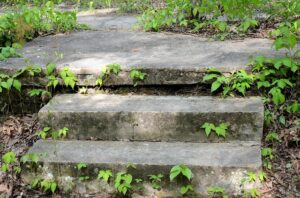Healing doesn’t happen all at once. It is a step by step process taking us from where we are to where we want to be. This step by step process is known as vinyasa krama in the eastern healing traditions of India.
As a path to healing vinyasa krama means to move step-by-step way towards a goal. These are not random steps. Each is part of an intentional and intelligently designed strategy to move in a given direction. The goal is personal and can be physical, mental, emotional, or anywhere in between.
The concept of vinyasa krama is pivotal in the planning a yoga practice. This concept is every bit as important when it comes to most forms of healing.
Vinyasa Krama and Healing
Health is more than an absence of disease. Rather, health is a state of physical, mental, and social well-being. True healing comes not when a problem is resolved but as feelings of openness, comfort, stability, and harmony develop. As positive feelings grow, those feelings of suffering decrease. As a result of shifting from suffering to well-being, the problem is resolved.
Many find this hard to understand in the midst of suffering. When in pain, stress, or when dealing with an illness, most people want to attack it. They simply want the pain to end and the sooner the better. Luckily, Patanjali, in his Yoga Sutra’s (Y.S.), laid out a path to help us move away from and even avoid suffering. The path is intentional. Purposefully taking the path step-by-step.
Pratipakṣa bhāvana
Patanjali says, to release suffering, movement or action needs to be made in a new direction. In yoga this is called pratipakṣa bhāvana. The concept comes from Y.S. chapter 2 verses 2.33 and 2.34. Prati means the opposite of or a different direction. Pakṣa is a side or other side, and bhāvana means to visualize or see. Pratipakṣa bhāvana then means to go toward or see another way or to go in a different direction.
Have you ever heard someone say, “just stop doing that?” That thing could be anything from smoking cigarettes, eating chocolate, looking at your phone, or numerous other things. We both know, it’s not that easy to stop doing what we’re used to doing. Likewise, it’s not that easy to START doing things differently, even if they are good for us.
It’s true. If there are cookies sitting next to the apples, I will almost always choose the cookies, even though I love apples. Luckily Yoga gives us some answers along the path. First of which is not to worry about the old pattern, called samskāras in Sanskrit. Instead, focus on the steps in your plan of action. They will lead us in a new direction.
Samskāras and Vāsanas

Samskāras are habitual patterns or behaviors. These patterns, beneficial or not, are here for a reason; they are here to help us. Underlying these patterns are what we call vāsanas. Vāsanas are feelings or impressions left-over from past events of situations. When we feel good about something, we do it more and it becomes a pattern. Likewise, when something doesn’t feel good, we get a different feeling, action, and pattern.
For example, when I was a young child, my mother took me to the dentist. I had a terrible experience. The dentist hurt me; I was afraid. As a result, I fought every step of the way and cried and cried. My mother, doing what she thought was best, held me down and yelled at me for being difficult child. My experience of fear and pain, (vāsana) of going to the dentist, became a samskāra of avoiding the dentist unless absolutely necessary. Even to this day, having worked through most of my anguish over the event, I still cringe at my bi-annual teeth cleaning.
So, what do we do? How do we move past these patterns?
One Possibility is Vinyasa Krama - A Path to Healing
New habits or patterns are created through intentional, appropriate, step-by-step movement in a chosen direction. It’s not enough just to take steps. The steps must be planned, suitable for and within a person’s capability.
Illness rarely comes on all at once. Physical problems or dis-ease is usually the result of long-term patterns (samskāras). This is easy to see in cases like diabetes where diet and lifestyle play a huge role. But the same is true for almost all health conditions. If we can understand the cause behind the symptoms, a goal can be made. Tools can then be chosen to move us from where we are towards the goal.
There is no “magic pill,” and herbal medicine works best, not as the only solution, but to support the body and mind while the solution is taking effect. Even when a person presents with an acute viral infection, like a cold or the flu. Herbs can support the healing process, improve immune function, and relieve some of the symptoms, but it does not cure the cold. The body heals itself. Rest, nutrition, and relaxation are needed. You would heal even without the herbs; it just may take more time.
Yoga Supports Healing
Yoga, on the other hand, directly supports the healing process. An appropriate yoga practice helps calm the mind and body while improving the flow of prāṇa or life energy, which in turn facilitates physical, mental, and emotional healing. Yoga supports the creation of new patterns. It helps improve the quality of our relationships with ourselves and others. All of this, and yoga works smoothly alongside any other healing modality that’s needed.
Illness and states of health range from simple to more complicated. The basics of developing a plan are the same.
- Understand the symptoms. (What is going on?)
- Identify the underlying cause of the problem.
- Develop a plan or series of goals.
- Choose appropriate tools to move forward, step-by-step toward the goal.
- Adjust the practice as needed.
Healing is a step-by-step process.
Because illness doesn’t happen all at once, healing usually takes time. When working with holistic methods, suggestions often involve uncomfortable changes. The more uncomfortable, the smaller and simpler the steps (unless the problem is life threatening). Small steps are easier to take, process and more likely to be long-lasting. Then, as we reach comfort with a small step, the next step can be taken.
A woman came to see me earlier this summer with terrible colitis. She was quite distressed having had incontinence for nearly 2 years. She was now losing weight and suffering digestive upset. Not liking the Dr’s suggestion of medication because of difficult side effects, she was seeking herbal therapy. For her though, it wasn’t herbs that helped the most. It was a change in diet and the way she thought and felt about food that brought her to a place of healing.
This was a slow process. A journey that took her from where she was, step-by-step to a healing diet that was quite restrictive. As you can imagine this was difficult. During the process, she confronted her own of deeply held anger and lack of control. Then, in the process of finding personal acceptance, she found healing for her lower abdomen and digestive tract. Once her body was digesting normally, with no pain or incontinence, she was able develop a new less restrictive diet. Thankfully she is now living symptom-free with the new regime.
This did not happen overnight but as part of a process, one involving multiple small goals and changing protocols.
It takes time and effort to change a pattern.
No matter the pattern, physical, mental, emotional or a combination, change does not come easily or at least not automatically. Once again Patanjali gives guidance. YS chapter 1 sutras 12 through 18 talks about to nuts and bolts involved in changing a long-term pattern or disease process.
In a nutshell, Patanjali suggests taking intentional, appropriate action towards a goal. He calls it abhyāsa or persevering practice. A persevering practice is a formalized or developed ritual that incorporates the vinyasa krama, or step-by-step plan of action. The practice is persevering because we don’t do it once, we do it every day. As a result of focusing on and practicing the new way every day, the old troublesome habits naturally drop away, replaced by new healthier ones.
At first even small steps can be difficult. But it gets easier. In fact, the more we practice, the more we are drawn to the direction we’d like to go. Until finally we look forward to the practice that was once uncomfortable. And most importantly, we feel better.
Let’s look at an example of a difficult lifestyle change.
A newly diagnosed diabetic must make significant dietary changes. In cases of type 2 diabetes, strong research indicates that the condition can reverse if a change in diet and lifestyle is embraced.
At first this is daunting. All the person can think about is what they can’t do, and what they cannot eat. This is where vinyasa krama is helpful. Suggestions and successes are taken in steps.

- The first step is to get rid of all the household foods not recommended. A hard step for many.
- Then, find some dietary options that work. This may not be an optimal diet but moves in that direction. This person may need support planning meals and makings grocery lists. The important thing is that they buy into a plan they can live with. A focus forward in a new direction.
- Slowly, over time, the person learns to cook the new way and enjoys eating in a way that maintains healthy blood sugar levels.
- Finally, the new way of eating becomes standard, and they don’t even think of living the way they once did.
All of this is very individual. One person may eat cake because they are stressed and feel badly about themselves. Another may be stressed and depressed because they ate cake. Each person will take different steps toward optimal wellness.
Vinyasa Krama and Yoga Practice
The concept of vinyasa krama becomes a more concrete process when planning yoga practices. Here, a flow is created which respects the needs of the body, breath, and mind. Within the flow the practitioner moves from a normal position (like sitting or standing) to one that is unusual, then back again. Each step preparing for the next. In this way, the qualities of softness, comfort, and stability (sthiram and sukham) are experienced.
Stay tuned, we’ll talk about this next.
Further Reading

Natural Solutions for Vertigo
Dear Annie, do you know of any natural solutions to help relieve vertigo? It started over a year ago, but I’ve had very few episodes until recently. Its miserable. A few times now, I’ve been so dizzy; I get nauseous. My ears ring “normally” yet a few hours before the onset of a vertigo episode, my left ear rings louder.

Easy Ways to Make A Big Impact On Your Child’s Health
Welcome Guest Bloggers Greg and Carmen Moro, creators of “Bad” Parenting Advice. Improving the mental and physical health of your family can be a challenge,

Wart, Wart Go Away
Dear Annie, I have been battling a wart on my finger for the last 20 years. I’ve seen multiple dermatologists and even an orthopedic surgeon who

Astaxanthin and Lipothiamine – Memory Strengthening Strategies
Dear Annie, I wanted to share a memory-strengthening strategy with you. About 20 years ago (I’m 72) I started noticing my memory beginning to weaken, and

Bacopa – Nourishment for the brain
Bacopa, also known as Brahmi and Water Hyssop, has a long history of use in the indigenous medical systems of India and Sri Lanka. These
References
https://www.who.int/about/governance/constitution
Patanjali’s Yoga Sutra

